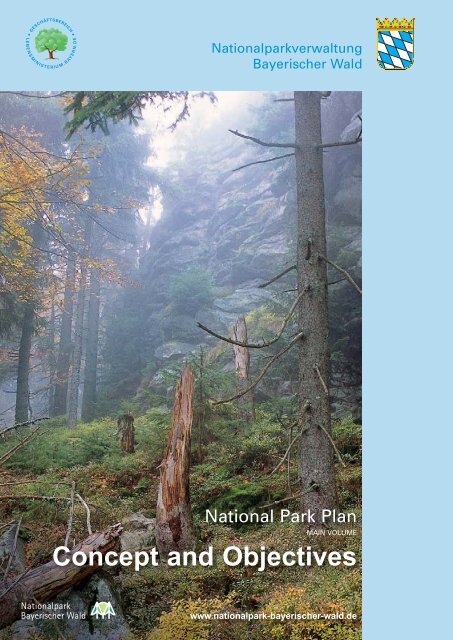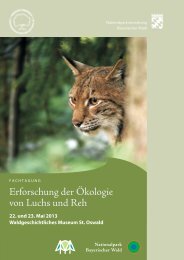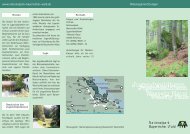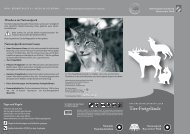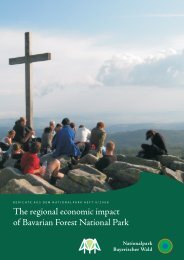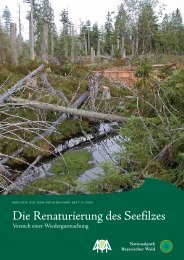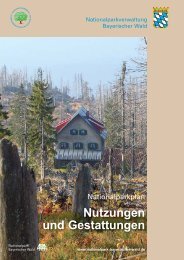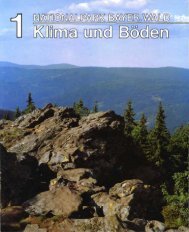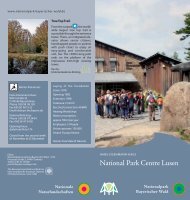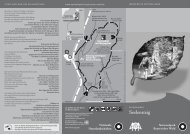Preparation of the National Park Plan - Nationalpark Bayerischer Wald
Preparation of the National Park Plan - Nationalpark Bayerischer Wald
Preparation of the National Park Plan - Nationalpark Bayerischer Wald
Create successful ePaper yourself
Turn your PDF publications into a flip-book with our unique Google optimized e-Paper software.
<strong>National</strong>parkverwaltung<br />
<strong>Bayerischer</strong> <strong>Wald</strong><br />
<strong>National</strong> <strong>Park</strong> <strong>Plan</strong><br />
MAIN VOLUME<br />
Concept and Objectives<br />
www.nationalpark-bayerischer-wald.de
Concept and Objectives
2 NATIONAL PARK PLAN 2010<br />
Dr. Marcel Huber MdL<br />
Staatsminister<br />
Melanie Huml MdL<br />
Staatssekretärin<br />
There is hardly ano<strong>the</strong>r country in Central Europe with<br />
such a variety <strong>of</strong> species and habitats as can be found in Bavaria.<br />
Alongside social security, unspoilt nature and a healthy<br />
environment play an increasingly important role for its people.<br />
Bavarian environment policy sets high standards in its pursuit<br />
<strong>of</strong> an intact environment, nature and landscape conservation as<br />
well as <strong>the</strong> sustainable use <strong>of</strong> resources. Protected areas, and in<br />
particular <strong>the</strong> national parks in Bavaria, play a significant role in<br />
this regard.<br />
"Let nature be nature" is <strong>the</strong> objective <strong>of</strong> <strong>the</strong> Bavarian Forest<br />
<strong>National</strong> <strong>Park</strong>, and in fact, <strong>the</strong>re is nowhere else between <strong>the</strong><br />
Atlantic and <strong>the</strong> Urals where such a large area <strong>of</strong> forests, bogs,<br />
mountain streams and lakes is allowed to develop according to<br />
its very own laws, into a unique wild forest landscape. Founded<br />
on 7 th October 1970 as <strong>the</strong> first national park in Germany it<br />
was extended on 1st August 1997, and now covers an area <strong>of</strong><br />
24,250 hectares. Toge<strong>the</strong>r with its immediate neighbour, <strong>the</strong><br />
Šumava <strong>National</strong> <strong>Park</strong> in <strong>the</strong> Czech Republic, <strong>the</strong> Bavarian<br />
Forest <strong>National</strong> <strong>Park</strong> comprises <strong>the</strong> largest continuous area <strong>of</strong><br />
forest in Central Europe.<br />
Protection is afforded above all to <strong>the</strong> spruce rich high<br />
forests, <strong>the</strong> mixed mountain forests <strong>of</strong> beech, fir and spruce as<br />
well as <strong>the</strong> bogs and meadow spruce forests in <strong>the</strong> hollows and<br />
valleys. Particularly valuable are <strong>the</strong> remnants <strong>of</strong> primeval<br />
forests at <strong>the</strong> foot <strong>of</strong> <strong>the</strong> Rachel and <strong>the</strong> Falkenstein, as well as<br />
<strong>the</strong> Schachten, former cattle grazing grounds which with <strong>the</strong>ir<br />
striking individual trees, remain witness to earlier human usage.<br />
Evidence <strong>of</strong> <strong>the</strong> high importance attributed internationally to<br />
<strong>the</strong> Bavarian Forest <strong>National</strong> <strong>Park</strong> includes its <strong>of</strong>ficial recognition<br />
by <strong>the</strong> IUCN (International Union for Conservation <strong>of</strong><br />
Nature) and <strong>the</strong> award <strong>of</strong> <strong>the</strong> European Diploma by <strong>the</strong><br />
Council <strong>of</strong> Europe.<br />
With around 760,000 visitors annually, <strong>the</strong> Bavarian Forest<br />
<strong>National</strong> <strong>Park</strong>, with its extensive network <strong>of</strong> hiking trails,<br />
numerous information facilities and wide range <strong>of</strong> environmental<br />
education courses, is also an important economic factor<br />
in <strong>the</strong> region. A study by <strong>the</strong> University <strong>of</strong> Würzburg has<br />
shown that <strong>the</strong> annual value generated by <strong>the</strong> national park is<br />
around €28 million.<br />
Based on <strong>the</strong> national park decree, <strong>the</strong> national park plan<br />
presented in this document sets out <strong>the</strong> medium term objectives<br />
and measures for <strong>the</strong> development <strong>of</strong> <strong>the</strong> Bavarian Forest<br />
<strong>National</strong> <strong>Park</strong>. It provides <strong>the</strong> national park administration<br />
with guidelines for its day to day work and o<strong>the</strong>r organisations<br />
and institutions involved with <strong>the</strong> national park as well as<br />
interested citizens with important information.<br />
Through coordination with <strong>the</strong> Bavarian State Ministry for<br />
Food, Agriculture and Forests, <strong>the</strong> Bavarian State Ministry for<br />
Economy, Infrastructure, Transport and Technology, <strong>the</strong> Local<br />
Government <strong>National</strong> <strong>Park</strong> Committee and <strong>the</strong> <strong>National</strong> <strong>Park</strong><br />
Advisory Board, <strong>the</strong> <strong>National</strong> <strong>Park</strong> <strong>Plan</strong> has been placed on<br />
a firm footing. We are convinced that it will make a significant<br />
contribution to fur<strong>the</strong>ring <strong>the</strong> development <strong>of</strong> <strong>the</strong> national park<br />
in <strong>the</strong> spirit <strong>of</strong> nature protection to <strong>the</strong> benefit <strong>of</strong> local people<br />
and visitors.
Content<br />
CONCEPT AND OBJECTIVES 3<br />
Introduction 4<br />
Concept <strong>of</strong> <strong>the</strong> Bavarian Forest <strong>National</strong> <strong>Park</strong> 8<br />
Objectives for <strong>the</strong> Development<br />
<strong>of</strong> <strong>the</strong> Bavarian Forest <strong>National</strong> <strong>Park</strong> 10<br />
1. Nature Protection 11<br />
2. Education, Information and Public Relations 14<br />
3. Research 18<br />
4. Recreation 20<br />
5. Integration <strong>of</strong> <strong>the</strong> <strong>National</strong> <strong>Park</strong> in <strong>the</strong> Region 24<br />
The Rachel Lake – <strong>the</strong> only natural<br />
glacial lake in <strong>the</strong> <strong>National</strong> <strong>Park</strong><br />
(Photo: Hans Kiener)
4 NATIONAL PARK PLAN 2010<br />
Introduction<br />
Transformed by a competitor – a beech seedling on rotten wood.<br />
(Photo: Karl Friedrich Sinner)<br />
The purpose <strong>of</strong> national parks across <strong>the</strong> world is <strong>the</strong><br />
preservation <strong>of</strong> unspoilt landscapes as national natural heritage<br />
for future generations. Nature in national parks should be<br />
allowed to develop according to its own laws and without<br />
human interference. <strong>National</strong> parks <strong>of</strong>fer visitors <strong>the</strong><br />
opportunity to experience nature (wilderness) largely<br />
uninfluenced by man and to get to know nature and how it<br />
works.<br />
<strong>National</strong> parks originated in North America, where <strong>the</strong><br />
Yellowstone <strong>National</strong> <strong>Park</strong> was founded in 1872. Nearly 100<br />
years later in 1970, <strong>the</strong> Bavarian Forest <strong>National</strong> <strong>Park</strong> became<br />
<strong>the</strong> first national park to be founded in Germany. Since <strong>the</strong>n,<br />
<strong>the</strong> number <strong>of</strong> national parks in Germany has risen to 14.<br />
A national park does not exist in isolation, but is an integral<br />
part <strong>of</strong> <strong>the</strong> region where it is located. There are numerous<br />
ecological and socio-economic interactions between <strong>the</strong><br />
protected area and its surroundings. Within <strong>the</strong> statutory<br />
objectives <strong>of</strong> national parks <strong>the</strong>re are competing aims. One <strong>of</strong><br />
<strong>the</strong> functions <strong>of</strong> a national park plan is to set out priorities in<br />
<strong>the</strong> management objectives <strong>of</strong> <strong>the</strong> national park and to lay down<br />
medium term measures as a basis for an annual action plan. In<br />
this way, <strong>the</strong> gradual development <strong>of</strong> a landscape hi<strong>the</strong>rto used<br />
by man into a natural landscape can be followed in a targeted<br />
way. <strong>National</strong> park plans are essential particularly in Central<br />
Europe, where because <strong>of</strong> <strong>the</strong> centuries-long human use, <strong>the</strong><br />
current population density and <strong>the</strong> multiplicity <strong>of</strong> interests and<br />
land usage requirements, make <strong>the</strong>m <strong>the</strong> only way to ensure <strong>the</strong><br />
development and continued existence <strong>of</strong> internationally<br />
recognised national parks.<br />
The current <strong>National</strong> <strong>Park</strong> <strong>Plan</strong> was prepared and compiled<br />
on <strong>the</strong> basis <strong>of</strong> <strong>the</strong> Bavarian Forest <strong>National</strong> <strong>Park</strong> ordinance <strong>of</strong><br />
22 nd July 1997 (NP-VO), amended on 17 th September 2007, by<br />
<strong>the</strong> <strong>National</strong> <strong>Park</strong> Administration in conjunction with <strong>the</strong> Local<br />
Government <strong>National</strong> <strong>Park</strong> Committee.<br />
After review by <strong>the</strong> advisory board, <strong>the</strong> <strong>National</strong> <strong>Park</strong> <strong>Plan</strong><br />
was approved by <strong>the</strong> Bavarian State Ministry for Environment<br />
and Health and came into force on <strong>the</strong> 22 nd December 2011.<br />
The approval was effected in agreement with <strong>the</strong> State<br />
Ministry for Food, Agriculture and Forestry as well as<br />
Economy, Transport and Technology.
<strong>Preparation</strong> <strong>of</strong> <strong>the</strong> <strong>National</strong> <strong>Park</strong> <strong>Plan</strong><br />
(Stages <strong>of</strong> Development)<br />
<strong>National</strong> <strong>Park</strong> Administration<br />
<strong>Preparation</strong><br />
Local Government <strong>National</strong> <strong>Park</strong> Committee<br />
Assistance<br />
<strong>National</strong> <strong>Park</strong> Advisory Board<br />
Review<br />
Ministries for Economic Affairs & Agriculture<br />
Ministry for Environment<br />
and Public Health<br />
Action, Agreement<br />
A pine marten – a furtive resident <strong>of</strong> <strong>the</strong> mountain forest<br />
(Photo: Karol Kaliský)<br />
Approval, Implementation<br />
CONCEPT AND OBJECTIVES 5
6 NATIONAL PARK PLAN 2010<br />
The prime function <strong>of</strong> <strong>the</strong> national park plan is to set out,<br />
in <strong>the</strong> medium term, <strong>the</strong> objectives and measures for <strong>the</strong><br />
national park which arise from <strong>the</strong> purpose and tasks set out in<br />
<strong>the</strong> national park regulation. In addition, <strong>the</strong> national park plan<br />
sets out <strong>the</strong> network <strong>of</strong> paths to be maintained, <strong>the</strong> forest<br />
conservation and forest stewardship measures, as well as <strong>the</strong><br />
development <strong>of</strong> zoning.<br />
The national park plan has initially been prepared for a<br />
planning period <strong>of</strong> 10 years. The detailed planning will be<br />
continued as necessary.<br />
Annexes<br />
The national park administration, in conjunction with <strong>the</strong><br />
local government national park committee, uses <strong>the</strong> national<br />
park plan as <strong>the</strong> basis for planning <strong>the</strong> individual measures and<br />
programmes within <strong>the</strong> operating plans. Supervisory control is<br />
exercised by <strong>the</strong> Bavarian State Ministry for Environment and<br />
Public Health. The publication <strong>of</strong> <strong>the</strong> national park plan is<br />
intended to inform <strong>the</strong> various departments and institutions<br />
concerned with <strong>the</strong> park <strong>of</strong> <strong>the</strong> objectives, tasks and legal basis<br />
as well as <strong>the</strong> current plans and measures.<br />
The national park plan is divided into a section on<br />
Objectives (Concept and Objectives) and Annexes (Sectoral<br />
and Detailed <strong>Plan</strong>s):<br />
Structure <strong>of</strong> <strong>the</strong> <strong>National</strong> <strong>Park</strong> <strong>Plan</strong>
County <strong>of</strong> Regen<br />
The terms ‘Altpark’ (original park) and ‘Erweiterungsgebiet’<br />
(park extension) are no longer used in <strong>the</strong> national park plan.<br />
After more than 10 years since <strong>the</strong> extension <strong>of</strong> <strong>the</strong> original<br />
national park (‘Altpark’) in 1997 to include <strong>the</strong> areas <strong>of</strong><br />
Klingenbrunn Forest and that <strong>of</strong> <strong>the</strong> former Zwiesel Forestry<br />
Office, with various areas bought in addition (‘Erweiterungsgebiet’),<br />
<strong>the</strong> terms are now out <strong>of</strong> date.<br />
Instead, <strong>the</strong> terms Falkenstein-Rachel-Area (Regen District<br />
Council) and Rachel-Lusen-Area (Freyung-Grafenau District<br />
Council) are used throughout. The border between <strong>the</strong> two areas<br />
is determined by <strong>the</strong> district council borders. This new division<br />
has resulted in some slight changes to <strong>the</strong> existing border:<br />
• The so-called Klingenbrunn Forest, which was within <strong>the</strong><br />
extended area, now belongs to <strong>the</strong> Rachel-Lusen-Area which<br />
o<strong>the</strong>rwise consists <strong>of</strong> <strong>the</strong> original <strong>National</strong> <strong>Park</strong> area <strong>of</strong> 1970<br />
County <strong>of</strong> Freyung-Grafenau<br />
CONCEPT AND OBJECTIVES 7<br />
<strong>National</strong> <strong>Park</strong> towns and villages<br />
Falkenstein-Rachel-Area<br />
Rachel-Lusen-Area<br />
<strong>National</strong> <strong>Park</strong> Border<br />
(<strong>the</strong> ‘original park area’). This is actually not a contradiction as<br />
<strong>the</strong> new nature zones had already been established here so<br />
that this area was already comparable with <strong>the</strong> original<br />
national park area with regard to zoning and management.<br />
• The Rachel Forest area on <strong>the</strong> north side <strong>of</strong> <strong>the</strong> Rachel<br />
Mountain now belongs to <strong>the</strong> ‘Falkenstein-Rachel-Area’. This<br />
area in <strong>the</strong> District <strong>of</strong> Regen has been part <strong>of</strong> <strong>the</strong> <strong>National</strong><br />
<strong>Park</strong> since 1971. O<strong>the</strong>rwise, <strong>the</strong> ‘Falkenstein-Rachel-Area<br />
covers <strong>the</strong> areas <strong>of</strong> <strong>the</strong> former Zwiesel Forestry Office with<br />
various areas bought in addition, which used to be known as<br />
<strong>the</strong> ‘Erweiterungsgebiet’.<br />
As a result <strong>of</strong> <strong>the</strong>se reforms, <strong>the</strong>re are also changes in <strong>the</strong><br />
area and zoning proportions. In addition, this new<br />
nomenclature does not mean any changes in respect <strong>of</strong> status<br />
and management <strong>of</strong> <strong>the</strong> areas.
8 NATIONAL PARK PLAN 2010<br />
Concept <strong>of</strong> <strong>the</strong> Bavarian Forest <strong>National</strong> <strong>Park</strong><br />
The Bavarian Forest <strong>National</strong> <strong>Park</strong> is responsible for protecting a typical Central European, mainly<br />
forested, low mountain range with its natural and semi-natural ecosystems as national natural<br />
heritage for present and future generations, in accordance with <strong>the</strong> Bavarian Law on Nature<br />
Protection and <strong>the</strong> <strong>National</strong> <strong>Park</strong> ordinance. The work <strong>of</strong> natural environmental forces and <strong>the</strong><br />
undisturbed dynamic <strong>of</strong> ecosystems are <strong>the</strong>reby ensured above all. The forests <strong>of</strong> <strong>the</strong> national park will<br />
<strong>the</strong>refore revert in <strong>the</strong> long term without human interference to natural forests. Events <strong>of</strong> nature such<br />
as wind and snow damage, toge<strong>the</strong>r with insect and fungus infestations, are important factors in <strong>the</strong><br />
natural development <strong>of</strong> <strong>the</strong> forest.<br />
Storm damage and insects determine <strong>the</strong> evolution <strong>of</strong> <strong>the</strong> mountain forest as ‘ecosystem engineers’ (Photo: Reinhold Weinberger)
The Three-toed Woodpecker benefits in <strong>the</strong> short term from <strong>the</strong> increase in insects after a bark beetle attack<br />
and can be easily seen at ‘work’ (Photo left: Rainer Simonis, Photo right: Maria Hußlein)<br />
In <strong>the</strong> border areas <strong>of</strong> <strong>the</strong> national park it is ensured that <strong>the</strong><br />
natural forest development will not have any negative effects on<br />
<strong>the</strong> neighbouring areas.<br />
There is no commercial use <strong>of</strong> natural resources within <strong>the</strong><br />
national park. Existing usage which is not compatible with <strong>the</strong><br />
protective purpose <strong>of</strong> <strong>the</strong> national park should cease as soon as<br />
possible – provided <strong>the</strong>re are no overwhelming reasons <strong>of</strong><br />
public good for allowing it to continue. Transitional periods are<br />
necessary for cultural and socio-economic reasons.<br />
As well as protecting natural processes <strong>the</strong> national park is<br />
also responsible for protection <strong>of</strong> species and habitats. The<br />
natural local animal and plant world should be retained and<br />
reintroduction made possible. Habitats surrounded by forest,<br />
such as bogs, areas <strong>of</strong> rock and water need to be protected or<br />
restored.<br />
Areas and monuments <strong>of</strong> cultural and historical importance<br />
are to be preserved in <strong>the</strong>ir typical appearance.<br />
CONCEPT AND OBJECTIVES 9<br />
The Bavarian Forest <strong>National</strong> <strong>Park</strong> is open for people to<br />
experience wilderness and for sustainable educational and<br />
leisure activities. This allows <strong>the</strong> objectives <strong>of</strong> <strong>the</strong> national park<br />
and <strong>the</strong> ecological relationships <strong>of</strong> natural processes to be<br />
communicated to <strong>the</strong> general public. As an institution for<br />
environmental education, it promotes <strong>the</strong> understanding <strong>of</strong><br />
nature and environmental protection. Educational and<br />
recreational facilities also contribute to <strong>the</strong> guiding <strong>of</strong> visitors.<br />
The findings <strong>of</strong> scientific studies and research on natural<br />
processes in forest ecosystems not touched by man also<br />
contributes to nature conservation, natural history education<br />
and natural forestry beyond <strong>the</strong> park boundaries.<br />
The national park shapes <strong>the</strong> appearance and character <strong>of</strong><br />
<strong>the</strong> region. As flagship for environmentally and culturally<br />
friendly tourism it streng<strong>the</strong>ns <strong>the</strong> economic infrastructure. The<br />
national park is interconnected with its surroundings ei<strong>the</strong>r side<br />
<strong>of</strong> its borders, from ecological, economic, political and cultural<br />
points <strong>of</strong> view. The interests <strong>of</strong> <strong>the</strong> local population are taken<br />
into account by <strong>the</strong> national park in its planning and actions.<br />
This is intended to encourage <strong>the</strong> integration and acceptance <strong>of</strong><br />
<strong>the</strong> national park in <strong>the</strong> region.
10 NATIONAL PARK PLAN 2010<br />
Objectives for <strong>the</strong> Development<br />
<strong>of</strong> <strong>the</strong> Bavarian Forest <strong>National</strong> <strong>Park</strong><br />
The national park is managed and developed in such a way as to give priority to <strong>the</strong> requirements <strong>of</strong><br />
nature conservation. At <strong>the</strong> same time, it is to promote environmental education, scientific knowledge<br />
and <strong>the</strong> experience <strong>of</strong> nature within <strong>the</strong> framework <strong>of</strong> nature protection. The national park should<br />
also contribute to <strong>the</strong> structural development <strong>of</strong> <strong>the</strong> region.<br />
In <strong>the</strong> following sections, <strong>the</strong> objectives within <strong>the</strong> individual areas <strong>of</strong> work are set out and expanded<br />
upon in order <strong>of</strong> importance. Where conflicts arise between competing objectives <strong>of</strong> equal value in <strong>the</strong><br />
areas <strong>of</strong> work, <strong>the</strong>se can only be resolved on a case by case basis.<br />
The gradual opening <strong>of</strong> <strong>the</strong> leaves means that not all trees are damaged by late frosts (Photo: Sven Zellner)
1. Nature Protection<br />
1.1. Preservation <strong>of</strong> a typical central European,<br />
mainly forested, low mountain range landscape<br />
<strong>National</strong> parks are, according to nature protection laws, <strong>the</strong><br />
most effective way <strong>of</strong> protecting large areas <strong>of</strong> natural or nearnatural<br />
landscape. In <strong>the</strong> densely populated landscapes <strong>of</strong><br />
central Europe, heavily influenced by human use, unspoilt and<br />
unfragmented areas <strong>of</strong> nature have become rare. The forested<br />
area <strong>of</strong> <strong>the</strong> inner Bavarian Forest along <strong>the</strong> Bavarian-Czech<br />
border is one <strong>of</strong> <strong>the</strong> few landscapes which can still be regarded<br />
as near-natural. This was also <strong>the</strong> reason for creating <strong>the</strong> first<br />
German national park in <strong>the</strong> Bavarian Forest in 1970 and<br />
extending it in 1997. The prime objective <strong>of</strong> <strong>the</strong> Bavarian Forest<br />
<strong>National</strong> <strong>Park</strong> is <strong>the</strong>refore to preserve this characteristic low<br />
mountain range landscape, with its natural and near-natural<br />
ecosystems, as a representative part <strong>of</strong> <strong>the</strong> nation’s natural<br />
heritage and to retain its essential character.<br />
CONCEPT AND OBJECTIVES 11<br />
The Honey Buzzard - a rare bird<br />
<strong>of</strong> prey in this area - hunts its prey<br />
on <strong>the</strong> ground<br />
(Photo: Rainer Simonis)<br />
1.2. Protection <strong>of</strong> <strong>the</strong> natural forest development,<br />
undisturbed by people<br />
According to <strong>the</strong> national regulations (Federal Law on<br />
Protection <strong>of</strong> Nature, Bavarian Law on Protection <strong>of</strong> Nature,<br />
<strong>National</strong> <strong>Park</strong> Ordinance) and international requirements<br />
(Habitats Directive, Birds Directive, IUCN Guidelines) <strong>the</strong><br />
first priority <strong>of</strong> <strong>the</strong> Bavarian Forest <strong>National</strong> <strong>Park</strong> should be to<br />
protect <strong>the</strong> natural dynamic <strong>of</strong> <strong>the</strong> ecosystems (protection <strong>of</strong><br />
natural processes). This means that, in <strong>the</strong> long term, at least<br />
three quarters <strong>of</strong> <strong>the</strong> forested area should be allowed to develop<br />
without human interference. Only in <strong>the</strong> border area <strong>of</strong> <strong>the</strong><br />
national park will <strong>the</strong>re be intervention in <strong>the</strong> natural<br />
development for <strong>the</strong> protection <strong>of</strong> forests bordering <strong>the</strong> park<br />
and also in <strong>the</strong> visitor attractions such as <strong>the</strong> animal enclosures.<br />
If forest regeneration in <strong>the</strong> high altitude areas is patchy or<br />
delayed, support should be given to <strong>the</strong> development <strong>of</strong><br />
appropriate natural vegetation. In <strong>the</strong> Falkenstein-Rachel area,<br />
natural forest development is being carried out on 75% <strong>of</strong> <strong>the</strong><br />
area during a transition period lasting until 2027.
12 NATIONAL PARK PLAN 2010<br />
1.3. Conservation and reintroduction <strong>of</strong> native animal<br />
and plant species<br />
The large near-natural habitats in <strong>the</strong> national park are <strong>of</strong><br />
national and international importance for species protection.<br />
The national park places particular emphasis on <strong>the</strong><br />
preservation and reintroduction <strong>of</strong> <strong>the</strong> natural biological<br />
diversity. This happens to a great extent through <strong>the</strong> natural<br />
development <strong>of</strong> <strong>the</strong> ecosystem.<br />
In <strong>the</strong> course <strong>of</strong> history, settlement and use <strong>of</strong> <strong>the</strong> Bavarian<br />
Forest have permanently changed <strong>the</strong> animal and plant world.<br />
For example, ho<strong>of</strong>ed game animals currently have to be<br />
managed because <strong>of</strong> <strong>the</strong> lack <strong>of</strong> natural predators and disruptive<br />
environmental factors, (see Appendix ‘Schalenwildmanagement’).<br />
O<strong>the</strong>r species were deliberately eliminated or are now<br />
under serious threat because <strong>of</strong> changes to <strong>the</strong>ir habitats and<br />
o<strong>the</strong>r disturbances. In <strong>the</strong>se cases, supportive measures are<br />
required, in order to prevent a stark reduction in numbers or<br />
even complete disappearance from <strong>the</strong> region (see Appendix ‚<br />
Arten- und Biotopschutz ). The designation <strong>of</strong> peaceful zones<br />
(core areas with no access) supports <strong>the</strong>se species protection<br />
measures.<br />
The Höllbachgespreng and waterfall<br />
in <strong>the</strong> Falkenstein area have been<br />
a protected nature area since 1941<br />
(Photo: Hans Kiener)<br />
1.4. Preservation and Reestablishment <strong>of</strong> Natural,<br />
Unforested Habitats<br />
From a nature protection point <strong>of</strong> view, unforested habitats<br />
such as moors and areas <strong>of</strong> rock and water represent<br />
a significant enrichment <strong>of</strong> <strong>the</strong> diversity <strong>of</strong> habitats. An<br />
undisturbed development <strong>of</strong> <strong>the</strong>se naturally tree-free areas is<br />
also an objective. However for reasons <strong>of</strong> species and habitat<br />
protection, especially where <strong>the</strong>re has been human interference,<br />
positive measures can be necessary (see Appendix ‘Renaturierung<br />
/ Renaturalization’).<br />
Disruptive influences by visitors, in particular, need to be<br />
avoided in <strong>the</strong>se sensitive habitats. The direction <strong>of</strong> visitors<br />
should achieve <strong>the</strong> minimum <strong>of</strong> damage.
The Knotenbachklause near Altschönau – a timber rafting cultural<br />
heritage site (Photo: Hans Kiener)<br />
1.5. Socially responsible phasing out <strong>of</strong> existing uses that<br />
are in conflict with national park objectives<br />
A natural ecosystem development can only be guaranteed<br />
if existing uses that are in conflict with <strong>the</strong> national park<br />
objectives are phased out. Because <strong>of</strong> socio-economic<br />
requirements this happens within a socially responsible<br />
transition period. When <strong>the</strong> existing uses end, <strong>the</strong><br />
infrastructure connected with <strong>the</strong>m can also be removed. This<br />
does not affect special rights and measures permitted when <strong>the</strong><br />
national park law came into force, such as water usage. (see<br />
Appendix ‘Nutzungen und Gestattungen’).<br />
1.6. Preservation <strong>of</strong> valuable cultural landscapes and<br />
monuments<br />
Pastures, sites <strong>of</strong> former glassworks, logging dams and<br />
canals as well as to some extent also former forest workers’ huts<br />
and logging tracks are evidence <strong>of</strong> <strong>the</strong> cultural and historical<br />
development <strong>of</strong> <strong>the</strong> region. Such valuable objects are <strong>the</strong>refore<br />
to be preserved for <strong>the</strong> education <strong>of</strong> future generations.<br />
Fur<strong>the</strong>rmore, <strong>the</strong> grazing areas enrich <strong>the</strong> diversity <strong>of</strong> habitats<br />
within <strong>the</strong> forest ecosystem. They are <strong>the</strong>refore to be preserved<br />
in <strong>the</strong>ir present extent.<br />
Monitoring <strong>of</strong> nature protection regulations and providing<br />
information to visitors are major tasks <strong>of</strong> <strong>the</strong><br />
<strong>National</strong> <strong>Park</strong> Administration (Photo: Chris Gat)<br />
CONCEPT AND OBJECTIVES 13<br />
1.7. Consolidation <strong>of</strong> <strong>the</strong> national park area with areas<br />
valuable for nature protection<br />
The process <strong>of</strong> developing <strong>the</strong> national park includes<br />
consolidating additional areas valuable for nature protection<br />
through acquisition which significantly contribute to <strong>the</strong> legal<br />
duty <strong>of</strong> <strong>the</strong> national park for nature protection. Priority is given<br />
to areas within <strong>the</strong> stipulated external borders <strong>of</strong> <strong>the</strong> national<br />
park, which have stood in <strong>the</strong> way <strong>of</strong> renaturation measures so<br />
far, which are in protected areas that existed prior to <strong>the</strong><br />
foundation <strong>of</strong> <strong>the</strong> national park (e.g. Klosterfilz), which<br />
contribute to reducing <strong>the</strong> border area <strong>of</strong> <strong>the</strong> national park<br />
and/or are valuable for species and habitat protection.<br />
1.8. Guaranteeing <strong>the</strong> observation <strong>of</strong> protection<br />
regulations in <strong>the</strong> national park<br />
The Bavarian Forest <strong>National</strong> <strong>Park</strong> can only fulfil its<br />
objective <strong>of</strong> protection if <strong>the</strong> observation <strong>of</strong> protection<br />
regulations can be guaranteed. Primarily responsible for<br />
monitoring <strong>the</strong> protection regulations is <strong>the</strong> <strong>National</strong> <strong>Park</strong><br />
Ranger Service. Their presence at places where <strong>the</strong>re are many<br />
visitors and in areas sensitive to disturbance counters damaging<br />
behaviour. Explaining, informing and advising visitors are <strong>the</strong><br />
main elements <strong>of</strong> <strong>the</strong>ir work.
14 NATIONAL PARK PLAN 2010<br />
2. Environmental Education, Information<br />
and Public Relations<br />
2.1. Communication <strong>of</strong> <strong>the</strong> purpose and objectives <strong>of</strong><br />
national parks, in particular <strong>the</strong> Bavarian Forest<br />
<strong>National</strong> <strong>Park</strong><br />
The most important task <strong>of</strong> <strong>the</strong> work in environmental<br />
education, information and public relations is to communicate<br />
<strong>the</strong> purpose <strong>of</strong> <strong>the</strong> national park – <strong>the</strong> protection <strong>of</strong> natural<br />
processes (see Appendix „Bildungs-, Informations- und<br />
Öffentlichkeitsarbeit“). Every visitor who takes part in<br />
a <strong>National</strong> <strong>Park</strong> educational activity should gain an understanding<br />
<strong>of</strong> <strong>the</strong> basic concept <strong>of</strong> nature conservation in <strong>the</strong><br />
national park, <strong>of</strong> protecting nature for its own sake. Interest in<br />
and understanding <strong>of</strong> <strong>the</strong> workings <strong>of</strong> undisturbed nature in its<br />
various forms should be nurtured in and made accessible to<br />
visitors. The national park visitor should grapple with <strong>the</strong><br />
relevant <strong>the</strong>mes as actively as possible.<br />
A particular focus <strong>of</strong> <strong>the</strong> work in education, information<br />
and public relations is to inform visitors about <strong>the</strong> particular<br />
natural processes <strong>of</strong> forest development and regeneration within<br />
<strong>the</strong> Bavarian Forest <strong>National</strong> <strong>Park</strong>. In addition, <strong>the</strong> necessary<br />
commands and prohibitions should also be explained and <strong>the</strong><br />
reason and necessity for <strong>the</strong>m made clear, <strong>the</strong>reby increasing <strong>the</strong><br />
acceptance <strong>of</strong> <strong>the</strong> whole national park. Results <strong>of</strong> current<br />
research should also inform <strong>the</strong> educational work.<br />
The wide variety <strong>of</strong> educational options should appeal to<br />
<strong>the</strong> largest possible range <strong>of</strong> people and should be designed as<br />
far as possible according to technique (e.g. guided tours,<br />
lectures, exhibitions, media) and facilities (e.g. information<br />
points, educational trails) for specific target groups (e.g. local<br />
people, tourists, children).<br />
Snow shoe walks – an increasingly popular way <strong>of</strong> experiencing <strong>the</strong> forest wilderness <strong>of</strong> <strong>the</strong> <strong>National</strong> <strong>Park</strong> in winter (Photo: Maria Hußlein)
2.2. Environmentally friendly accessibility <strong>of</strong> <strong>the</strong><br />
national park for educational purposes<br />
In accordance with <strong>the</strong> national park regulations, <strong>the</strong><br />
Bavarian Forest <strong>National</strong> <strong>Park</strong> should be made accessible to <strong>the</strong><br />
public for educational and recreational purposes. Natural<br />
history education and nature-based recreation are connected in<br />
that <strong>the</strong> recreational facilities always fulfil an educational role<br />
and vice versa.<br />
Educational and o<strong>the</strong>r information is communicated in <strong>the</strong><br />
open air as well as in special visitor and information facilities<br />
(see Appendix „Bildungs- und Erholungseinrichtungen”). The<br />
information facilities in <strong>the</strong> area include a network <strong>of</strong> marked<br />
paths and nature trails as well as guided tours organised by <strong>the</strong><br />
national park administration. The main educational centres <strong>of</strong><br />
<strong>the</strong> Bavarian Forest <strong>National</strong> <strong>Park</strong> are <strong>the</strong> Lusen <strong>National</strong> <strong>Park</strong><br />
Centre (Hans-Eisenmann-Haus with tree top walk, animal<br />
enclosures, plant and rock displays), <strong>the</strong> Falkenstein <strong>National</strong><br />
<strong>Park</strong> Centre (Haus zur Wildnis with animal enclosures and<br />
Stone Age cave), <strong>the</strong> Jugendwaldheim (forest youth house), <strong>the</strong><br />
Wilderness Camp at <strong>the</strong> Mount Falkenstein as well as <strong>the</strong> forest<br />
playground. These information and educational centres were<br />
built on <strong>the</strong> edge <strong>of</strong> <strong>the</strong> national park and serve environmental<br />
education as well as visitor management purposes.<br />
The national park administration’s educational programme<br />
also includes facilities close to <strong>the</strong> national park such as <strong>the</strong><br />
Forest History Museum in St. Oswald and <strong>the</strong> national park<br />
information points in Bayerisch Eisenstein, Zwiesel, Frauenau,<br />
Mauth and Spiegelau.<br />
CONCEPT AND OBJECTIVES 15<br />
2.3. Promotion <strong>of</strong> general environmental education<br />
The educational work <strong>of</strong> <strong>the</strong> Bavarian Forest <strong>National</strong> <strong>Park</strong><br />
is not just confined to <strong>the</strong> aims and objectives <strong>of</strong> national parks;<br />
it should also encourage a general understanding <strong>of</strong> nature and<br />
environmental protection, as well as stimulate action. The<br />
educational work <strong>of</strong> <strong>the</strong> national park with its fascinating<br />
natural environment provides a unique natural experience. It<br />
provides an active experience <strong>of</strong> nature and raises <strong>the</strong> question<br />
<strong>of</strong> whe<strong>the</strong>r this experience can be transferred to o<strong>the</strong>r areas <strong>of</strong><br />
life; it’s not just about nature but also about people’s personal<br />
development.<br />
Increasingly, elements <strong>of</strong> education for sustainable<br />
development are being implemented. Education for sustainable<br />
development is not a subject but a process. It goes fur<strong>the</strong>r than<br />
ecological questions and covers also economic and social issues.<br />
In relation to education for sustainable development and in<br />
keeping with its model role, <strong>the</strong> national park tries to direct its<br />
activities and facilities to provide a model for excellent<br />
environmental management, with <strong>the</strong> objective <strong>of</strong> achieving<br />
EMAS certification.<br />
The Bavarian Forest <strong>National</strong> <strong>Park</strong> as part <strong>of</strong> a worldwide<br />
network <strong>of</strong> protected areas also has <strong>the</strong> opportunity to apply<br />
elements <strong>of</strong> global knowledge.<br />
In <strong>the</strong> Bavarian Forest <strong>National</strong> <strong>Park</strong>, methods from <strong>the</strong><br />
experience oriented communication <strong>of</strong> knowledge have been<br />
developed and put into practice under <strong>the</strong> motto <strong>of</strong> “Experience<br />
<strong>the</strong> Forest – Understand Nature”. These have since been taken<br />
up by many o<strong>the</strong>r educational establishments. Our role as<br />
a pioneer in environmental education should be maintained and<br />
fur<strong>the</strong>r developed.<br />
Emphasis in <strong>the</strong> environmental education programme is on<br />
youth work. An objective is also to work closely toge<strong>the</strong>r with<br />
<strong>the</strong> Bavarian Forest Nature <strong>Park</strong>.
16 NATIONAL PARK PLAN 2010<br />
The detail <strong>of</strong> a clump <strong>of</strong> moss and <strong>the</strong> delicate beauty <strong>of</strong> its<br />
features can only be truly appreciated through <strong>the</strong> lens<br />
<strong>of</strong> a magnifying glass (Photo: Thomas Stephan)<br />
2.4. Promoting integration and acceptance <strong>of</strong> <strong>the</strong><br />
national park amongst <strong>the</strong> local population<br />
The nature protection objective <strong>of</strong> national parks („Let<br />
nature be nature“) is in conflict with <strong>the</strong> thinking which has<br />
dominated in Germany since <strong>the</strong> beginning <strong>of</strong> nature protection<br />
in <strong>the</strong> 19th century, which takes a very static view <strong>of</strong> <strong>the</strong><br />
preservation <strong>of</strong> certain situations (e.g. <strong>the</strong> appearance <strong>of</strong> some<br />
agricultural landscapes). As this idea is almost totally based on<br />
cultural heritage (on what is “man made”) it is extremely<br />
difficult to get local agreement on protection areas where nature<br />
should be allowed to develop according to its own laws.<br />
In <strong>the</strong> Bavarian Forest <strong>National</strong> <strong>Park</strong>, <strong>the</strong> national park<br />
objective mostly requires <strong>the</strong> rejection <strong>of</strong> active or guiding<br />
measures, whilst allowing forests to develop, grow and die<br />
naturally. For <strong>the</strong> local population, <strong>the</strong>ir image <strong>of</strong> <strong>the</strong> forest is<br />
still strongly influenced by <strong>the</strong> farming <strong>of</strong> <strong>the</strong> forest. The fact<br />
that <strong>the</strong> forests <strong>of</strong> <strong>the</strong> national park are now governed by a quite<br />
different objective and <strong>the</strong> dying <strong>of</strong> individual trees or even<br />
whole areas <strong>of</strong> old trees is regarded as a natural development,<br />
At exhibitions and o<strong>the</strong>r national events, <strong>the</strong> Bavarian Forest<br />
and Šumava <strong>National</strong> <strong>Park</strong> regions use <strong>the</strong> joint brand ‘tierisch wild’<br />
(untamed wilderness) (Photo: Britta Baums)<br />
makes acceptance <strong>of</strong> <strong>the</strong> national park by sections <strong>of</strong> <strong>the</strong> local<br />
population very problematic. The national park administration<br />
takes <strong>the</strong> concerns, fears and requirements <strong>of</strong> <strong>the</strong> local<br />
population seriously. Without a degree <strong>of</strong> consensus amongst<br />
<strong>the</strong> local population in favour <strong>of</strong> <strong>the</strong>ir nature protection<br />
objectives, national parks cannot survive in <strong>the</strong> long term.<br />
The most important function <strong>of</strong> public relations work is that<br />
<strong>the</strong> employees <strong>of</strong> <strong>the</strong> national park administration communicate<br />
<strong>the</strong> importance and objectives <strong>of</strong> <strong>the</strong> national park to <strong>the</strong> local<br />
population. Each one is expected to contribute to enhancing <strong>the</strong><br />
image <strong>of</strong> <strong>the</strong> national park.<br />
In addition, <strong>the</strong> acceptance and integration <strong>of</strong> <strong>the</strong> national<br />
park should be promoted through work with existing local<br />
organisations and educational institutions (especially with <strong>the</strong><br />
nature park) as well as through greater openness and<br />
involvement <strong>of</strong> <strong>the</strong> local population in decisions on <strong>the</strong> future<br />
development <strong>of</strong> <strong>the</strong> national park. The local government<br />
national park committee and <strong>the</strong> national park advisory board<br />
also play an important role in this process.
2.5. Informing <strong>the</strong> population <strong>of</strong> <strong>the</strong> activities and plans<br />
<strong>of</strong> <strong>the</strong> national park administration<br />
Central to <strong>the</strong> public relations work is reporting on plans,<br />
developments and current operations in <strong>the</strong> national park as<br />
well as <strong>the</strong> activities <strong>of</strong> <strong>the</strong> national park administration. The<br />
public relations work should contribute to <strong>the</strong> realisation <strong>of</strong> <strong>the</strong><br />
objectives <strong>of</strong> <strong>the</strong> national park as well as enhance understanding<br />
<strong>of</strong> <strong>the</strong> work <strong>of</strong> <strong>the</strong> national park administration. Successful<br />
external public relations work also requires appropriate<br />
communication <strong>of</strong> information internally. As all employees in<br />
contact with <strong>the</strong> population carry out public relations work,<br />
it is essential that all staff receive <strong>the</strong> necessary information and<br />
pass it on.<br />
The local government national park committee and <strong>the</strong><br />
national park advisory board also play an important role here.<br />
CONCEPT AND OBJECTIVES 17<br />
2.6. Portrayal <strong>of</strong> <strong>the</strong> national park and <strong>the</strong> work <strong>of</strong> <strong>the</strong><br />
national park administration in <strong>the</strong> media<br />
Public relations work in and for <strong>the</strong> national park is<br />
interpreted in <strong>the</strong> widest sense. This includes on <strong>the</strong> one hand<br />
working with media such as newspapers, magazines, radio and<br />
TV and on <strong>the</strong> o<strong>the</strong>r hand individual events such as<br />
anniversaries, open days, presentations <strong>of</strong> <strong>the</strong> national park at<br />
exhibitions or local festivals. Drawing on <strong>the</strong> background <strong>of</strong> <strong>the</strong><br />
national park idea and its special aims and role in nature<br />
conservation, <strong>the</strong> priority <strong>of</strong> <strong>the</strong> national park’s public relations<br />
work is to present <strong>the</strong> work <strong>of</strong> <strong>the</strong> national park administration,<br />
as well as <strong>the</strong> natural evolution in <strong>the</strong> national park, to <strong>the</strong><br />
widest possible audience. Public relations work in <strong>the</strong> future<br />
should be as active as possible, in order to streng<strong>the</strong>n positive<br />
representation and reporting in <strong>the</strong> media.<br />
Guided tours and o<strong>the</strong>r events give guests a wide range <strong>of</strong> opportunities to experience wilderness (Photo: Maria Hußlein)
18 NATIONAL PARK PLAN 2010<br />
3. Research<br />
3.1. Formulation <strong>of</strong> <strong>the</strong> scientific principles for <strong>the</strong><br />
implementation <strong>of</strong> national park objectives<br />
In order to realise long term planning objectives and<br />
optimum efficiency <strong>of</strong> <strong>the</strong> national park administration, it is<br />
necessary to undertake a careful appraisal <strong>of</strong> <strong>the</strong> animate and<br />
inanimate natural environment <strong>of</strong> <strong>the</strong> national park (inventory).<br />
The research into this basic information should provide results<br />
on <strong>the</strong> landscape, natural and cultural history <strong>of</strong> <strong>the</strong> area, <strong>the</strong><br />
settlements and infrastructure, <strong>the</strong> former and existing uses as<br />
well as <strong>the</strong> current research situation.<br />
When carrying out research in <strong>the</strong> national park, it is<br />
important to take care that <strong>the</strong> research methods applied have<br />
as little impact as possible on <strong>the</strong> natural development <strong>of</strong> <strong>the</strong><br />
ecosystem. Observational research should normally take priority<br />
over experimental research methods in <strong>the</strong> area being studied.<br />
3.2. Monitoring <strong>the</strong> efficiency <strong>of</strong> <strong>the</strong> management <strong>of</strong> <strong>the</strong><br />
national park<br />
It is <strong>of</strong> fundamental importance for effective management <strong>of</strong><br />
<strong>the</strong> national park that <strong>the</strong> effectiveness <strong>of</strong> measures to achieve<br />
objectives is monitored continuously. The optimisation <strong>of</strong> <strong>the</strong>se<br />
measures requires continuous use <strong>of</strong> scientific observation and<br />
research. The results <strong>of</strong> <strong>the</strong> research work should serve to<br />
formulate scientific recommendations for fur<strong>the</strong>r support and<br />
improved implementation <strong>of</strong> measures for nature protection.<br />
This research work also needs to take account <strong>of</strong> <strong>the</strong><br />
surrounding area as <strong>the</strong>re is considerable interaction between<br />
<strong>the</strong> development <strong>of</strong> <strong>the</strong> national park and its surroundings.<br />
3.3. Research and documentation <strong>of</strong> <strong>the</strong> development <strong>of</strong><br />
<strong>the</strong> forest ecosystems without human influence<br />
The main emphasis <strong>of</strong> scientific observation in <strong>the</strong> Bavarian<br />
Forest <strong>National</strong> <strong>Park</strong> is <strong>the</strong> research and documentation <strong>of</strong> <strong>the</strong><br />
development <strong>of</strong> <strong>the</strong> forest ecosystems in predominantly natural<br />
ways, uninfluenced by man. The development <strong>of</strong> <strong>the</strong> forest, <strong>the</strong><br />
ecosystems and <strong>the</strong> range <strong>of</strong> species should be documented by<br />
long term monitoring <strong>of</strong> representative sectors (long term<br />
observation areas, inventories). Special questions are dealt with<br />
in supplementary project research. In <strong>the</strong> interests <strong>of</strong><br />
effectiveness <strong>the</strong>se can also be awarded to third parties (e.g.<br />
universities, scientific institutes). As a result <strong>of</strong> <strong>the</strong> death <strong>of</strong><br />
large areas <strong>of</strong> old mountain spruce, research into natural forest<br />
succession in <strong>the</strong> areas <strong>of</strong> higher altitude is particularly<br />
important.<br />
3.4. Recording <strong>of</strong> human influences and <strong>the</strong>ir impact on<br />
<strong>the</strong> ecosystems<br />
Worldwide <strong>the</strong>re are no natural landscapes left which are<br />
completely unaffected by humankind. In comparison with<br />
commercial forests, <strong>the</strong> forests in <strong>the</strong> national park can develop<br />
without any direct human exploitation. Thus <strong>the</strong> forests <strong>of</strong> <strong>the</strong><br />
national park can be drawn on as zero areas for <strong>the</strong> recording <strong>of</strong><br />
man-made influences and <strong>the</strong>ir impact on <strong>the</strong> ecosystems for<br />
purposes <strong>of</strong> comparative research.<br />
Research proposals <strong>of</strong> <strong>the</strong> national park in <strong>the</strong> area <strong>of</strong> pure<br />
research and environmental monitoring (e.g. ECE - „Integrated<br />
Monitoring“ in <strong>the</strong> trout stream area) should be included in<br />
national and international research projects.
3.5. Recording <strong>of</strong> socio-economic and socio-ecological<br />
interrelationships<br />
Research in <strong>the</strong> Bavarian Forest <strong>National</strong> <strong>Park</strong> should also<br />
identify <strong>the</strong> interrelationship between <strong>the</strong> national park, <strong>the</strong><br />
surrounding area, national park visitors and <strong>the</strong> population <strong>of</strong><br />
<strong>the</strong> region. Important aspects are, on <strong>the</strong> one hand, <strong>the</strong><br />
socioeconomic effects, i.e. <strong>the</strong> significance <strong>of</strong> <strong>the</strong> national park<br />
for <strong>the</strong> economic development <strong>of</strong> <strong>the</strong> region. On <strong>the</strong> o<strong>the</strong>r<br />
hand, <strong>the</strong> socio-ecological effects for <strong>the</strong> implementation <strong>of</strong><br />
nature protection objectives are vital, that is, <strong>the</strong> extent to which<br />
<strong>the</strong> natural processes in <strong>the</strong> national park are impacted by<br />
visitors and recreational users <strong>of</strong> <strong>the</strong> national park and by<br />
developments in <strong>the</strong> surrounding areas.<br />
3.6. Exploitation and processing <strong>of</strong> research results for<br />
nature protection, science and forestry practices as<br />
well as environmental education and public relations<br />
The scientific studies in <strong>the</strong> national park enable insights<br />
into pristine ecosystems as well as for cultivated areas outside<br />
<strong>the</strong> national park to be derived and especially <strong>the</strong> recognition <strong>of</strong><br />
<strong>the</strong> correlations between man and nature. Knowledge <strong>of</strong> natural<br />
processes in forests not used by people is particularly valuable<br />
for nature protection, science and nature-oriented forestry. The<br />
research results should be made available to <strong>the</strong> towns and<br />
CONCEPT AND OBJECTIVES 19<br />
Systems for automatic measurement <strong>of</strong> meteorological and olfactory data (Photo: Heiner Rall)<br />
villages close to <strong>the</strong> national park and also <strong>the</strong> members <strong>of</strong> <strong>the</strong><br />
national park advisory board. In addition, <strong>the</strong> research should<br />
underpin <strong>the</strong> educational and public relations work <strong>of</strong> <strong>the</strong><br />
national park. The research results should be formatted in such<br />
a way that <strong>the</strong>y can be available at short notice and generally be<br />
easy to understand. The methods and opportunities <strong>of</strong> data<br />
processing (databases, geographical information systems,<br />
networks etc.) should be used in <strong>the</strong> documentation <strong>of</strong> research<br />
results.<br />
3.7. Interpretation and overview <strong>of</strong> research results<br />
important for <strong>the</strong> national park<br />
The national park administration can only carry out its<br />
functions as far as nature protection, education and public<br />
relations are concerned if <strong>the</strong> necessary information and findings<br />
converge at <strong>the</strong>ir <strong>of</strong>fices. It is incumbent upon <strong>the</strong> administration<br />
that <strong>the</strong>y have a complete overview. The basis for completion <strong>of</strong><br />
<strong>the</strong> various research tasks is a research concept (see Appendix<br />
“Forschung”). This is essential for setting <strong>the</strong> priorities for <strong>the</strong><br />
research plan, <strong>the</strong> coordination <strong>of</strong> <strong>the</strong> work (potentially by third<br />
parties) and for excluding research proposals which compromise<br />
<strong>the</strong> purpose <strong>of</strong> protection or lie outside <strong>the</strong> national park’s<br />
specific areas <strong>of</strong> interest. It is also important, that research<br />
results from outside <strong>the</strong> national park are tied in with <strong>the</strong><br />
research work <strong>of</strong> <strong>the</strong> national park and discussed.
20 NATIONAL PARK PLAN 2010<br />
4. Recreation<br />
4.1. Opening <strong>of</strong> <strong>the</strong> national park to environmentally<br />
sustainable forms <strong>of</strong> recreation and nature<br />
experience<br />
According to current legal rules as well as <strong>the</strong> IUCN<br />
guidelines, national parks are responsible for education and<br />
recreational objectives as well as nature protection. As <strong>the</strong>se are<br />
in essence conflicting objectives, <strong>the</strong> national park ordinance<br />
stipulates that <strong>the</strong> establishment <strong>of</strong> <strong>the</strong> national park is for<br />
recreational activities which protect nature and that <strong>the</strong>se<br />
activities may not adversely affect <strong>the</strong> protective purpose <strong>of</strong> <strong>the</strong><br />
national park. The compatibility <strong>of</strong> recreational activities with<br />
nature will be measured primarily against effects on <strong>the</strong><br />
ecosystem, in particular <strong>the</strong> animal and plant world.<br />
A perfectly structured network <strong>of</strong> paths makes a significant<br />
contribution to environmentally sustainable recreation in <strong>the</strong><br />
national park. Visitors to <strong>the</strong> park are brought to <strong>the</strong> special<br />
features and wild forest on well marked paths. The number and<br />
condition <strong>of</strong> <strong>the</strong> paths as well as <strong>the</strong> signposting have to reflect<br />
<strong>the</strong> protective purpose <strong>of</strong> <strong>the</strong> national park. Areas <strong>of</strong> <strong>the</strong><br />
national park which are particularly sensitive cannot be<br />
included. The path network for <strong>the</strong> various recreational<br />
activities can be found in <strong>the</strong> Appendix “Wegeplan”.<br />
The mountain summits <strong>of</strong> <strong>the</strong> <strong>National</strong> <strong>Park</strong> – this is on <strong>the</strong> Lusen – are amongst <strong>the</strong> most popular destinations (Photo: Alice Alteneder)
4.2. Creating opportunities for experiencing unspoilt<br />
nature (“Wilderness”)<br />
As <strong>the</strong>re are hardly any areas in central Europe with<br />
unspoilt nature, <strong>the</strong> image <strong>of</strong> nature is strongly influenced by<br />
<strong>the</strong> picture <strong>of</strong> cultural landscapes. The aim <strong>of</strong> <strong>the</strong> Bavarian<br />
Forest <strong>National</strong> <strong>Park</strong> is <strong>the</strong>refore to create opportunities to<br />
experience unspoilt nature (“wilderness”). As <strong>the</strong> alienation<br />
from nature takes hold in <strong>the</strong> large conurbations and industrial<br />
centres, so <strong>the</strong> need for untouched nature grows. With<br />
resources such as <strong>the</strong> “Seelensteig” nature trail or programmes<br />
such as <strong>the</strong> “nature experience days” <strong>the</strong> Bavarian Forest<br />
<strong>National</strong> <strong>Park</strong> helps to meet this need.<br />
CONCEPT AND OBJECTIVES 21<br />
4.3. Construction and fur<strong>the</strong>r development <strong>of</strong> modern<br />
visitor facilities for environmental education and<br />
recreational activities<br />
As well as an attractive network <strong>of</strong> paths, special visitor and<br />
o<strong>the</strong>r facilities increase considerably <strong>the</strong> attractiveness <strong>of</strong> <strong>the</strong><br />
national park. The most important visitor facilities in <strong>the</strong><br />
Bavarian Forest <strong>National</strong> <strong>Park</strong> are <strong>the</strong> <strong>National</strong> <strong>Park</strong> Centres<br />
Lusen (Hans-Eisenmann-Haus with tree top walk, and animal,<br />
plant and rock enclosures) and Falkenstein (Haus zur Wildnis<br />
with animal enclosures and Stone Age cave). These facilities are<br />
not just for visitor recreation but also above all for<br />
environmental education.<br />
The latest teaching methods were taken into account during<br />
<strong>the</strong> establishment and in <strong>the</strong> subsequent development <strong>of</strong> <strong>the</strong>se<br />
facilities in order to maintain and enhance <strong>the</strong>ir attractiveness.<br />
In addition, <strong>the</strong> visitor facilities make a considerable<br />
contribution to visitor management <strong>the</strong>reby helping to protect<br />
sensitive natural areas. For this reason, most <strong>of</strong> <strong>the</strong> visitor<br />
facilities are located around <strong>the</strong> edge <strong>of</strong> <strong>the</strong> national park.<br />
In <strong>the</strong> Falkenstein-Rachel Area <strong>the</strong> visitor facilities are more<br />
or less complete so future development is directed mainly at<br />
modernisation <strong>of</strong> facilities in <strong>the</strong> Rachel-Lusen area. The<br />
construction and running <strong>of</strong> visitor facilities also contributes to<br />
<strong>the</strong> attractiveness <strong>of</strong> <strong>the</strong> region to tourists and <strong>the</strong> acceptance <strong>of</strong><br />
<strong>the</strong> national park amongst <strong>the</strong> local population. (see Appendix<br />
„Bildungs-und Erholungseinrichtung“).<br />
One <strong>of</strong> <strong>the</strong> major functions <strong>of</strong> <strong>the</strong> national park<br />
administration is ensuring <strong>the</strong> safety <strong>of</strong> all <strong>the</strong> visitor facilities<br />
(including <strong>the</strong> network <strong>of</strong> paths).
22 NATIONAL PARK PLAN 2010<br />
A hands on approach for <strong>the</strong> first experience <strong>of</strong> <strong>the</strong> fascinating world<br />
<strong>of</strong> untamed nature in <strong>the</strong> <strong>National</strong> park (Photo: Maria Hußlein)<br />
4.4. Assistance for national park visitors<br />
The Bavarian Forest <strong>National</strong> <strong>Park</strong>, with its unique nature<br />
and its visitor attractions, <strong>of</strong>fers many opportunities for<br />
recreation and experiencing nature. Hundreds <strong>of</strong> thousands <strong>of</strong><br />
visitors come to <strong>the</strong> national park every year. Providing<br />
assistance for <strong>the</strong>se guests is a considerable task for <strong>the</strong> national<br />
park administration.<br />
As well as information about <strong>the</strong> objectives and purpose <strong>of</strong><br />
<strong>the</strong> Bavarian Forest <strong>National</strong> <strong>Park</strong>, visitors are also provided<br />
with information with which to plan <strong>the</strong>ir stay in <strong>the</strong> national<br />
park. Visitors should be aware <strong>of</strong> <strong>the</strong> various opportunities to<br />
experience nature, special features and also possible dangers in<br />
The <strong>National</strong> <strong>Park</strong> uses distinctively carved wood to<br />
present itself and its facilities (Photo: Maria Hußlein)<br />
<strong>the</strong> national park. In addition, information is also provided on<br />
<strong>the</strong> educational and recreational facilities around <strong>the</strong> national<br />
park (and nature park). Visitors can find <strong>the</strong> information at <strong>the</strong><br />
national park centres and information points, in <strong>the</strong> form <strong>of</strong><br />
personal advice, flyers, books, exhibitions, films and information<br />
boards. The <strong>National</strong> <strong>Park</strong> Ranger Service has an important<br />
role in assisting visitors in <strong>the</strong> field.<br />
The safety <strong>of</strong> national park visitors, including care for <strong>the</strong>m<br />
in emergencies, is covered by appropriate actions (traffic<br />
calming, <strong>the</strong> presence <strong>of</strong> <strong>the</strong> <strong>National</strong> <strong>Park</strong> Ranger Service at<br />
well-frequented visitor locations, procedures for raising <strong>the</strong><br />
alarm and rescue.).
4.5. Coordination and harmonisation in <strong>the</strong> provision<br />
<strong>of</strong> recreational and visitor facilities<br />
As <strong>the</strong> size and purpose <strong>of</strong> <strong>the</strong> national park mean that it<br />
can only provide visitor facilities to a certain extent, more visitor<br />
infrastructure has been set up in <strong>the</strong> area around <strong>the</strong> national<br />
park. In addition, <strong>the</strong>re are many recreational facilities provided<br />
by o<strong>the</strong>rs (e.g. Bavarian Forest Nature <strong>Park</strong>, nearby towns and<br />
villages) in <strong>the</strong> area around <strong>the</strong> national park. With respect to<br />
“gentle” nature tourism, <strong>the</strong> provision <strong>of</strong> recreational facilities is<br />
best coordinated, also in a transboundary manner toge<strong>the</strong>r with<br />
<strong>the</strong> Šumava <strong>National</strong> <strong>Park</strong>.<br />
CONCEPT AND OBJECTIVES 23<br />
Simple devices like bug eye viewers provide a fascinating insight into <strong>the</strong> habitat <strong>of</strong> small organisms such as <strong>the</strong> caddis fly (Photo: Joachim Hußlein)
24 NATIONAL PARK PLAN 2010<br />
5. Integration <strong>of</strong> <strong>the</strong> national park<br />
in <strong>the</strong> region<br />
5.1. Streng<strong>the</strong>ning <strong>the</strong> ecological, cultural and economic<br />
basis <strong>of</strong> <strong>the</strong> region around <strong>the</strong> national park and its<br />
development<br />
When <strong>the</strong> Bavarian Forest <strong>National</strong> <strong>Park</strong> was founded and<br />
extended, as well as nature protection objectives, it had <strong>the</strong><br />
structural development <strong>of</strong> <strong>the</strong> region in mind, particularly <strong>the</strong><br />
development <strong>of</strong> tourism. Due to its visitor facilities and<br />
opportunities for recreation, <strong>the</strong> Bavarian Forest <strong>National</strong> <strong>Park</strong><br />
has become an economic motor in <strong>the</strong> region and has <strong>the</strong>refore<br />
fulfilled its objective extremely well.<br />
Within <strong>the</strong> framework <strong>of</strong> its nature protection objectives <strong>the</strong><br />
national park will make a particular effort to enhance <strong>the</strong><br />
attractiveness <strong>of</strong> <strong>the</strong> region to tourists.<br />
The target towards which we are working is <strong>the</strong> realisation<br />
<strong>of</strong> a model economic ecological region with natural and cultural<br />
landscapes side by side. When possible, <strong>the</strong> national park<br />
administration will support measures (exhibitions, educational<br />
trails, educational facilities, concepts) in <strong>the</strong> region, when <strong>the</strong>se<br />
correspond with <strong>the</strong> objectives <strong>of</strong> an ecological model region<br />
and <strong>the</strong> national park. Concerning this objective, all planners in<br />
<strong>the</strong> area around <strong>the</strong> national park should ensure that <strong>the</strong>y avoid<br />
developments that damage nature and <strong>the</strong> landscape <strong>the</strong>reby<br />
reducing <strong>the</strong> recreational value <strong>of</strong> <strong>the</strong> national park region.<br />
More than 70 mainly tourism related enterprises in <strong>the</strong> national park region are partners <strong>of</strong> <strong>the</strong> national park.<br />
A win-win situation which also benefits holiday visitors (Photo: Ernstlh<strong>of</strong>/Kaikenried)
The first broken and moss covered branches enrich <strong>the</strong> mono-culture<br />
areas developed in <strong>the</strong> 150 years <strong>of</strong> cultivated forest<br />
(Photo: Konrad Jäger)<br />
5.2. Protection <strong>of</strong> <strong>the</strong> forests bordering <strong>the</strong> national park<br />
In <strong>the</strong> Bavarian Forest <strong>National</strong> <strong>Park</strong> <strong>the</strong> vast majority <strong>of</strong><br />
<strong>the</strong> forest area is allowed to develop without human interference<br />
and return to its natural state. Natural occurences like wind and<br />
snow damage and insect and fungus infestation are part <strong>of</strong><br />
natural forest development and do not require any human<br />
intervention. However in <strong>the</strong> area bordering <strong>the</strong> national park it<br />
is important to make sure that <strong>the</strong>re are no negative effects on<br />
neighbouring land from <strong>the</strong> natural forest development in <strong>the</strong><br />
national park. The national park administration takes necessary<br />
and effective forest protection measures in a border area at least<br />
500 metres wide in order to protect <strong>the</strong> neighbouring forest.<br />
These forest protection measures as well as <strong>the</strong> exact<br />
boundaries <strong>of</strong> <strong>the</strong> border area are set out in <strong>the</strong> Appendix<br />
“<strong>Wald</strong>erhaltungs- und <strong>Wald</strong>pflegemaßnahmen”.<br />
The objective <strong>of</strong> protecting <strong>the</strong> neighbouring forests from<br />
damage is a basic prerequisite for <strong>the</strong> integration and acceptance<br />
<strong>of</strong> <strong>the</strong> national park in <strong>the</strong> region. The national park<br />
administration gives this aspect <strong>the</strong> highest priority in its<br />
planning <strong>of</strong> measures to be taken.<br />
The so-called attractant panels help to monitor<br />
<strong>the</strong> progress <strong>of</strong> swarming <strong>of</strong> <strong>the</strong> large spruce<br />
bark beetle (Photo: Hans Kiener)<br />
5.3. Protection <strong>of</strong> <strong>the</strong> high altitude forests<br />
CONCEPT AND OBJECTIVES 25<br />
As well as <strong>the</strong> fundamental importance <strong>of</strong> <strong>the</strong> high altitude<br />
forests for water supply and <strong>the</strong> genetic potential <strong>of</strong> an<br />
indigenous cold climate spruce species in <strong>the</strong> low mountains,<br />
<strong>the</strong> mountain spruce forest (<strong>the</strong> “high forest”) is also <strong>of</strong> cultural<br />
and historical importance. For this reason, <strong>the</strong> old high altitude<br />
spruce forest in <strong>the</strong> Falkenstein-Rachel area needs to be<br />
protected from rapid and broad extinction. In <strong>the</strong> period to<br />
2027, <strong>the</strong> expansion <strong>of</strong> <strong>the</strong> bark beetle in <strong>the</strong> high altitude<br />
forest between <strong>the</strong> Falkenstein and Rachel is to be prevented.<br />
In <strong>the</strong> Rachel-Lusen area, where <strong>the</strong> old trees in <strong>the</strong> high<br />
altitude area have already been killed by bark beetle attack over<br />
a large area, <strong>the</strong> process <strong>of</strong> natural forest renewal should be<br />
allowed to continue unhindered. However, if <strong>the</strong> natural forest<br />
renewal fails to happen over a wide area and long period,<br />
support will be given to <strong>the</strong> development <strong>of</strong> a natural forest<br />
appropriate for <strong>the</strong> area.<br />
The relevant measures for combating <strong>the</strong> bark beetle and for<br />
forest protection as well as <strong>the</strong> exact boundaries <strong>of</strong> <strong>the</strong> zones are<br />
set out in <strong>the</strong> Appendix “<strong>Wald</strong>erhaltungs- und<br />
<strong>Wald</strong>pflegemaßnahmen”.
26 NATIONAL PARK PLAN 2010<br />
Through <strong>the</strong> German-Czech Youth Forum, young people gain direct experience <strong>of</strong> nature in <strong>the</strong> Bavarian Forest<br />
– Šumava <strong>National</strong> <strong>Park</strong> region and <strong>the</strong> wilderness becomes a familiar environment (Photo: Hans Kiener)<br />
5.4. Promotion <strong>of</strong> transboundary co-operation<br />
The Bavarian Forest and Šumava <strong>National</strong> <strong>Park</strong>s have<br />
a unique opportunity to create a cross border bilateral national<br />
park <strong>of</strong> European importance. Close cooperation in <strong>the</strong><br />
realisation <strong>of</strong> <strong>the</strong> objectives <strong>of</strong> both national parks is <strong>the</strong>refore<br />
essential. The most important elements in <strong>the</strong> development <strong>of</strong><br />
a bilateral national park are agreed objectives and joint activities<br />
in nature protection, education, research, recreation and culture.<br />
Examples <strong>of</strong> cross border projects <strong>of</strong> <strong>the</strong> Bavarian Forest and<br />
Šumava <strong>National</strong> <strong>Park</strong>s include <strong>the</strong> forest hiking area in <strong>the</strong><br />
Finsterau/Bučina area, <strong>the</strong> Bavarian-Czech information and<br />
meeting centre at <strong>the</strong> border railway station in Bayerisch<br />
Eisenstein / Železná Ruda, cooperation between <strong>the</strong> two ranger<br />
services, joint Natura 2000 management planning and <strong>the</strong> joint<br />
lynx research project. These and <strong>the</strong> already existing cross<br />
border paths can also make a significant contribution to<br />
understanding between peoples and acceptance <strong>of</strong> <strong>the</strong> national<br />
parks in <strong>the</strong> region.<br />
5.5. Support for measures for improving <strong>the</strong> yields in<br />
agriculture and forestry in <strong>the</strong> areas around<br />
<strong>the</strong> national park<br />
There are many interactions between <strong>the</strong> national park and<br />
its surrounding areas. The national park is home to many rare<br />
and endangered animal species, whose habitat does not end at<br />
<strong>the</strong> borders <strong>of</strong> <strong>the</strong> national park. For many <strong>of</strong> <strong>the</strong>m, <strong>the</strong><br />
surrounding areas are an important extension <strong>of</strong> <strong>the</strong>ir habitat.<br />
In <strong>the</strong> winter months, when <strong>the</strong>re is considerable snow in <strong>the</strong><br />
national park, <strong>the</strong> surrounding areas are very important to<br />
many animal species as areas <strong>of</strong> refuge. The farmed landscapes<br />
around <strong>the</strong> national park can <strong>the</strong>refore make a considerable<br />
contribution to <strong>the</strong> protection <strong>of</strong> species. For this reason,<br />
environmentally sustainable measures for improvements in<br />
yields from agriculture and forestry in <strong>the</strong> areas surrounding<br />
<strong>the</strong> national park would be sensible (e.g. direct marketing).
5.6. Improvements in local public transport<br />
The Bavarian Forest <strong>National</strong> <strong>Park</strong> has hundreds <strong>of</strong><br />
thousands <strong>of</strong> visitors every year. Around 90% <strong>of</strong> leisure visitors<br />
arrive by car at present. On <strong>the</strong> one hand, this individual travel<br />
endangers <strong>the</strong> attractiveness <strong>of</strong> <strong>the</strong> national park region; on <strong>the</strong><br />
o<strong>the</strong>r hand it damages <strong>the</strong> quality <strong>of</strong> life <strong>of</strong> <strong>the</strong> local population.<br />
A high level <strong>of</strong> individual travel stands in contradiction to <strong>the</strong><br />
<strong>the</strong> main nature protection objectives <strong>of</strong> <strong>the</strong> national park.<br />
Therefore it has to be an objective to reduce <strong>the</strong> level <strong>of</strong><br />
motorized individual travel by increasing <strong>the</strong> use <strong>of</strong> public<br />
transport. Public transport should also be as environmentally<br />
friendly as possible. The railway (“<strong>Wald</strong>bahn”) and <strong>the</strong> Igelbus<br />
(hedgehog bus) system are particularly important.<br />
CONCEPT AND OBJECTIVES 27<br />
5.7. Information and agreement on measures and plans<br />
in <strong>the</strong> national park and <strong>the</strong> surrounding area<br />
The bodies represented in <strong>the</strong> local government national<br />
park committee, <strong>the</strong> nature park association and <strong>the</strong> national<br />
park administration have to inform each o<strong>the</strong>r <strong>of</strong> <strong>the</strong> measures<br />
and plans which are important for <strong>the</strong> national park and <strong>the</strong><br />
surrounding area and agree <strong>the</strong>m in good time. This should<br />
above all streng<strong>the</strong>n positive development opportunities, avoid<br />
bad developments and encourage <strong>the</strong> integration <strong>of</strong> <strong>the</strong> national<br />
park in <strong>the</strong> region.<br />
<strong>National</strong> <strong>Park</strong> Rangers <strong>of</strong>fer advice to visitors and are ambassadors for <strong>the</strong> <strong>National</strong> <strong>Park</strong> concept (Photo: Chris Gat)
28 NATIONAL PARK PLAN 2010<br />
On <strong>the</strong> way from <strong>the</strong> Rachel chapel to <strong>the</strong> summit <strong>of</strong> <strong>the</strong> Rachel <strong>the</strong>re are spectacular views across <strong>the</strong> endless forest – here from <strong>the</strong> banks <strong>of</strong><br />
<strong>the</strong> Rachel Lake (Photo: Hans Kiener)<br />
Impressum<br />
PUBLISHER: Bavarian Forest <strong>National</strong> <strong>Park</strong> Administration<br />
Freyungerstr. 2<br />
94481 Grafenau (NPBW)<br />
INTERNET: www.nationalpark-bayerischer-wald.de<br />
E-MAIL: poststelle@npv-bw.bayern.de<br />
GRAPHIC DESIGN: Václav Hraba, akademic painter and graphic artist<br />
AUTHORS: Jochen Linner, Josef Wanninger<br />
PHOTO EDITORS: Dr. Andrea Berger-Seefried, Maria Hußlein, Hans Kiener, Rosalinde Pöhlmann<br />
EDITORIAL OFFICE: Karin Hartl<br />
MAPS: Thomas Müller, Arthur Reinelt, Annemarie Schmeller<br />
PRINTER: Graphick Atelier H, Ltd; Prague<br />
COVER PHOTO: Among <strong>the</strong> wild rock formations <strong>of</strong> <strong>the</strong> rocky hiking area <strong>the</strong> nature <strong>of</strong> <strong>the</strong> national park<br />
shows <strong>of</strong>f its grandiose variety <strong>of</strong> forms and colours (Photo: Günter Moser)<br />
PICTURE PAGE 1: When <strong>the</strong> snow melts hollows and pools fill for a while with water and become spawning grounds<br />
for amphibians. (Photo: Bruno D`Amicis)<br />
PRINTED ON: Paper made from 100% recycled paper<br />
DATE: December 2010<br />
© NPBW<br />
ISBN-NR.: 978-3-930977-35-2<br />
PRICE OF THE<br />
COMPLETE WORKS: €39.80<br />
When quoting from this work, <strong>the</strong> use <strong>of</strong> references and receipt <strong>of</strong> a copy <strong>of</strong> <strong>the</strong> article / publication are requested.<br />
This work is copyrighted. All rights reserved. Although <strong>the</strong> content was compiled with <strong>the</strong> utmost care, no liability for correctness<br />
and completeness can be assumed. We are not responsible for <strong>the</strong> content <strong>of</strong> any websites where links have been provided.
The Bavarian Forest <strong>National</strong> <strong>Park</strong> is<br />
A holder <strong>of</strong> <strong>the</strong> European Diploma (awarded 1986);<br />
A certified transboundary park (awarded 2009);<br />
The largest terrestrial Natura 2000 site in Germany;<br />
A Member <strong>of</strong> EUROPARC Deutschland, <strong>the</strong> umbrella organisation<br />
for Germany’s large protected areas “<strong>National</strong> Natural Landscapes”.<br />
BAYERN | DIREKT is your direct line to <strong>the</strong> Bavarian government. By calling<br />
089 122220 or sending an E-mail to direkt@bayern.de you can obtain material,<br />
brochures and information on subjects <strong>of</strong> current interest and useful internet sites,<br />
as well as details <strong>of</strong> authorities, appropriate contact points and contact persons<br />
in <strong>the</strong> Bavarian government.


